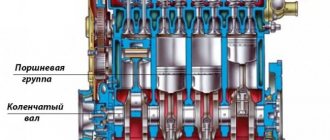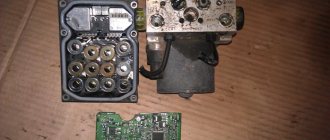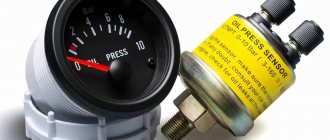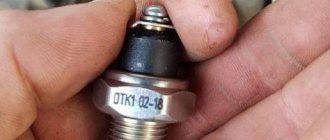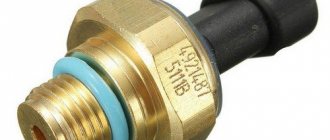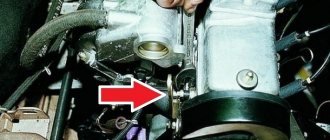The oil pressure indicator is flashing: 10 common reasons and is it safe to drive?
The oil pressure warning light on the dashboard coming on is a fairly common problem. The indicator turns on when the pressure in the engine lubrication system drops below the permissible level. Under such circumstances, it is recommended to first check the engine oil level and add it if necessary. If this does not help, then you should find the cause of such failures and take measures to resolve the problems.
Why does the sensor work?
The reasons for this can be very different:
- insufficient oil level;
- problems with the lubrication system;
- damage to the engine oil pan;
- poorly performed overhaul of the power unit or its untimely and improper maintenance.
To determine the cause of the operation, first of all, it is important to note exactly when the oil pressure light came on, immediately after starting or while driving, and how exactly it lights up. Does it blink or not, if it blinks, does it depend on the crankshaft speed, does it go out as the engine warms up or with an increase in crankshaft speed, etc.
What problems does the oil pressure indicator indicate?
The warning light cannot accurately indicate the quality or level of engine oil. The main task of the device is to fix oil pressure or its absence inside the lubrication system line.
The indicator turning on may be caused by the following malfunctions:
- poor quality motor oil;
- pressure sensor failure;
- decreased oil pump performance, loss of performance;
- unsuitable oil for a particular engine;
- filter clogging;
- excessive wear of the internal combustion engine piston group elements.
The warning light may flash or stay on immediately after starting a cold engine. On the other hand, this phenomenon can occur at idle speed of a warm engine.
It should be taken into account that the indicator briefly turning on or blinking is quite normal, since pressure is created when the starter cranks the crankshaft.
If the light stays on for a long time, this indicates problems that need to be identified and eliminated as soon as possible.
What could be the cause of the glowing light bulb:
- Faulty oil pump. During the operation of the car, the internal and external parts of the body of this unit inevitably wear out. In the case of gear devices, friction pairs become unusable. Also here the pump pressure reducing valve may fail due to clogging of its lumen or spring breakage. Here you can try to clean it or change the spring. In addition, in the best case scenario, the mesh may become dirty, which can simply be removed and cleaned. Despite various reasons, the result will be pressure surges inside the engine lubrication system.
- Low engine oil level. If the indicator lights up immediately after starting a cold engine and does not turn off after 10-15 seconds of operation, then you should turn off the car, open the hood and check the level with a dipstick. If necessary, you just need to add oil with the same characteristics. When such a situation occurs on the road, you need to stop, wait a few minutes for the lubricant to drain, and check the level with a dipstick. It is often better to change the oil completely.
- Problems with the oil filter. This consumable material has a clear service life. A low-quality product may work intermittently from the very beginning. Even a high-quality filter element becomes dirty over time, so it needs to be changed along with the oil.
- Faulty oil pressure sensor. You can check the device using a multifunction tester or pressure gauge. In addition, it is better to pay special attention to the quality of electrical contacts. In case of malfunctions, the device only needs to be replaced.
- Level sensor failure. The mechanical element needs to be removed and cleaned, and the wiring checked.
- Engine oil leaks. This problem often occurs due to wear of oil seals and gaskets.
Under such circumstances, it is better to inspect the elements of the fuel system, check the cylinder head gasket, and the presence of oil stains on the engine block.
- Significant wear of piston group elements. Here you should pay attention to blue smoke from the exhaust pipe and decreased compression.
- Damage to the cylinder head gasket. This is one of the most dangerous causes of pressure drop inside the oil system. Driving with such a problem is strictly prohibited, as the risk of engine jamming with subsequent expensive repairs increases.
- Incorrectly selected oil. This refers to temperature properties and viscosity. The pressure inside the engine oil system depends on these parameters.
- If antifreeze, gasoline or diesel fuel gets inside the oil. Because of this, the lubricant loses its viscosity characteristics. Such problems are indicated by white smoke from the exhaust pipe. It is necessary to check the integrity of the cylinder head gasket.
Why does it burn for a long time and then go out?
It's all simple guys - the problem is in the oil filter, it is because of it that this problem occurs. Let's remember how an oil filter works - the pump pumps oil pressure into the system, including the filter element, then the oil seeps through the filter paper, leaving behind dirt and other waste particles (chips, dust, dirt, burnt marks, etc.).
You need to understand that oil should not come out of the filter after stopping the engine. That is, the pump built up pressure into it, and it should remain there, that is, the lubricant should not return to the pan.
It is when the lubricant flows into the engine sump that the pump needs some time after starting to completely pump the system again. And at this time your pressure lamp is on. This takes from 3 to 10 seconds, it all depends on the manufacturer, design, volume, etc.
BUT why does the oil pressure hold in one filter element and not in the other? What is the reason? It's simple...
How long can you drive with a flashing light?
Despite the fact that a burning or flashing light does not always indicate a disaster, in such circumstances you need to stop, turn off the engine, check the engine oil level, and add it if necessary.
If such measures do not bring results, then you need to use a tug or tow truck to deliver the vehicle to the garage. When the indicator blinks, you can get to the repair site on your own, avoiding acceleration.
Operating a car with low oil level or low oil pressure is quite dangerous. Under such circumstances, mechanical and thermal loads on the engine increase to a critical level. In such cases, the engine may simply jam, so it is better to add oil as soon as possible.
If there is a lack of lubrication, the likelihood of damage to the antifriction material increases, and scuffing on the liners, crankshaft journals and camshafts appears quite intensively.
How long you can drive with the light on depends directly on the cause of this situation. First of all, you need to check the oil level using a dipstick. If necessary, top it up to normal or replace it completely. Before this, it is better to slowly get to the repair site. If you don’t do this, you may end up with a major expensive repair.
Thus, the absence or lack of engine lubrication can lead to serious damage, so you need to promptly and adequately respond to indicator signals on the dashboard.
How DDM works
The oil sensor is simple to operate: the measuring membrane changes its position under the influence of pressure, which leads to the opening or closing of the contacts. When the oil level drops, the membrane falls off and the contacts become disconnected. This triggers a signal displayed on the instrument panel.
It happens that the oil level is normal, but the oil pressure sensor on the Lada Granta still does not work correctly. In such a situation, it is recommended to find and check the performance of the meter itself.
Without proper experience in working with technical equipment, you should not climb under the hood, as there is a possibility of damaging the car.
The main reasons for the oil pressure warning light to come on
So, the warning light usually lights up after starting the engine or when it is idling. There may be several reasons for this phenomenon, but the main thing is to understand and accept for yourself that this should be a signal that there is some kind of malfunction. Therefore, you need to take appropriate measures so as not to worsen the situation. In any case, if the lamp blinks, it means that you need to identify the malfunction and do everything to eliminate it as soon as possible.
Among the main reasons for the indicator to light up are the following:
Lack of lubrication may be associated with failure of the pressure relief valve. It should be in the closed position if the pressure level in the system is insufficient. However, when the valve fails or gets stuck, the pressure generated is not enough, which causes the warning light to light up.- Another reason is a faulty pressure sensor. It is directly related to the operation of the control indicator, since it is connected to it by the same wire. As soon as the pressure returns to normal, the contacts should open, as a result of which the indicator should go out. This will not happen if the sensor itself has become faulty.
- The indicator also starts blinking if the oil pump screen is clogged. It acts as an obstacle to particles of dirt, metal, dust and any other unwanted elements that lead to wear on the pump. If the oil is not dirty, but of normal quality, then it freely penetrates through the mesh. When it is contaminated, the required pressure is not created in the system, which leads to the warning lamp coming on. Most often, this reason manifests itself on a cold engine, because as it warms up, the lubricant becomes more liquid and passes through the mesh much more easily.
The oil pump itself may also fail. It is this that creates an acceptable level of pressure in the entire system. If this does not happen, the sensor contacts close, which leads to the appearance of a signal indicator on the panel. Therefore, in this case, you will have to dismantle the oil pan and pump to eliminate the problem.
Anti-drainage valve as a reason
The so-called “anti-drainage valve” maintains the oil pressure inside the filter; it is this that “locks” the lubricating component inside. If this valve fails or is made of low-quality materials, then it will not work! Here's the reason.
But what is it, what does it consist of? Guys, essentially the valve is a banal rubber band, or now it’s just ordinary silicone
However, rubber (silicone) also comes in different qualities, and the assembly of the product also plays an important role.
It happens that immediately after changing the oil, a long extinguishment of the pressure lamp appears. This means either there is simply no rubber band (valve), or it has fallen off or torn (from “high” quality). THIS FILTER NEEDS TO BE CHANGED IMMEDIATELY! BECAUSE THE QUALITY IS SIMPLY “BELOW BELOW PINBOARD”, IT IS STILL NOT CLEAR WHAT IS THERE WITH THE FILTER PAPER.
It is also not uncommon for the light to start to light up after a certain mileage, say after 1000 - 3000 km. This also tells us that the anti-drainage valve is of poor quality, that is, the rubber has become “stiff” (or baked) from the high temperatures of the oil, and no longer holds it inside. It is also worth getting rid of such an element.
How does the oil sensor work and why can it fail?
Now let's consider the situation if you are on the road and the low pressure indicator has triggered.
The very first thing you need to do is stop the vehicle and turn off the engine. As soon as it cools down, you will have to check the lubricant level in the system. There is a special dipstick under the hood for this purpose. It is wiped dry and immersed in its original place. It is quite possible that the level will be below the minimum level. This means that somewhere there is a leak or depressurization of connections. You can set off again only after adding oil to the engine. If the lamp continues to light after starting and does not go out subsequently, it makes sense to think about towing the car to the nearest service station or to a trusted auto mechanic. The matter may turn out to be quite serious, so it is advisable to conduct the examination in a calm environment. Since we have already said that the causes of low pressure may be associated with a faulty sensor, it would be useful to understand the principle of operation of this device. There are certain contacts inside it. Until the ignition is turned on, there is no pressure in the system, so the contacts are closed. When you turn the key and turn on the ignition, but before the starter starts, the warning lamp should be on. If this does not happen, then there may be some kind of malfunction. Maybe the light bulb itself simply burned out, or maybe the contacts were broken or the sensor itself failed. As soon as we start the engine, the contacts open, leading to the light bulb going out.
The oil pressure light does not go out for a long time when starting a cold Grant engine
It’s unlikely to burst, but it may stop performing its functions. Like in my case, rubber turned into plastic
If the sealing ring is installed correctly and is 100% intact, can it burst after some time while standing in its place in the oil pump?
When parked overnight, if you unscrew the filter, not two drops of oil should fall if the valve is working?
As in my case, rubber turned into plastic.
starting and as soon as the engine started the light went out after 1s maximum.
I turn off the switch and immediately turn the key; the pressure light on the device does not light up immediately, but with a slight delay, that is, it indicates that the pressure remains in the system for some time, which is good
what kind of nonsense are you writing?
If the anti-drain valve in the filter works as expected, then when you unscrew the filter, a normal amount of oil should spill out, because when you unscrew it from the channels, the oil also drains, this is if the valve in the filter is alive. If the valve in the filter does not work, then the oil from the channels during parking flows into the sump and when unscrewed after the night, practically no oil flows out because all the glass flows into the crankcase through holes on the surface of the valve. and the ring that you changed only serves to seal the oil receiver-oil pump connection, and so that the oil sucked from the bottom rises without loss, otherwise there will be loss on the receiver-oil pump connection.
All to say that your filter is garbage. The same amount should drain as when replacing the filter on a warm engine during an oil change, i.e. oil from the vertical channel all the way to the cylinder head, and plus from the filter itself, until you have time to turn it upside down with the hole.
The same amount should drain as when replacing the filter on a warm engine during an oil change, i.e. oil from the vertical channel all the way to the cylinder head, and plus from the filter itself, until you have time to turn it upside down with the hole.
Apparently the valve of this filter allows zero zero.
Can not. And it can’t dry out if it’s of high quality,
what kind of nonsense are you writing?
Not nonsense, but just a plus to the shrunken ring and the valve did not hold in the filter.
otherwise there will be a loss in the receiver-oil pump connection.
Not nonsense, but just a plus to the shrunken ring and the valve did not hold in the filter.
with the valve working, I got just two or three drops and it was dripping.
what kind of nonsense are you writing?
If the anti-drain valve in the filter works as expected, then when you unscrew the filter, a normal amount of oil should spill out, because when you unscrew it from the channels, the oil also drains, this is if the valve in the filter is alive. If the valve in the filter does not work, then the oil from the channels during parking flows into the sump and when unscrewed after the night, practically no oil flows out because all the glass flows into the crankcase through holes on the surface of the valve. and the ring that you changed only serves to seal the oil receiver-oil pump connection, and so that the oil sucked from the bottom rises without loss, otherwise there will be loss on the receiver-oil pump connection.
All to say that your filter is garbage. The same amount should drain as when replacing the filter on a warm engine during an oil change, i.e. oil from the vertical channel all the way to the cylinder head, and plus from the filter itself, until you have time to turn it upside down with the hole.
The same amount should drain as when replacing the filter on a warm engine during an oil change, i.e. oil from the vertical channel to the cylinder head itself, and plus from the filter itself, until you have time to turn it upside down with a hole
Plus, during startup, the pump not only draws oil through the intake, but also air leaks through a leak in the sealing ring, which is located above the oil level in the crankcase
The author most likely had a problem with the filter for the most part.
How to check pressure
If it is not possible to contact a car service in the near future, you can try to find the cause yourself, and for this we need to find out how to check the oil pressure. A special device that measures the pressure in the system is designed for these purposes. It is sold ready-made or you can make it yourself based on any pressure gauge, a rubber hose with a fitting, the thread of which should be the same as that of the oil sensor.
First you need to unscrew the thread on the sensor, preparing for the fact that oil will immediately begin to flow. After this, a pressure gauge is inserted into the system and the engine is started. At the time of startup, a second person must watch the instrument readings. If the value is less than 0.5 kg/cm2, it is necessary to stop the engine.
How to measure engine oil pressure
This is a service operation. It’s hard to even imagine that a simple car owner would have a special pressure gauge at hand. Such a device will help to obtain accurate values at any speed. This will allow the diagnostician to recognize the malfunction and avoid it.
Drawing. Pressure gauge connection diagram.
Let's look at a specific example. Let's take 2 petrol versions of the Land Cruiser Prado 150. The lubrication pressure of these cars is measured at 3000 rpm. But the standards for engines differ. So for a gasoline 2.7 it corresponds to the range of 1.6-5 atmospheres, and for a 4-liter: already 3-6 atmospheres. As you can see, even for the same manufacturer the numbers vary greatly. What will happen then if we are talking about Volkswagen, Skoda, BMW, Mercedes?
Conclusion - there are no universal standards, and testing methods for each engine model, as mentioned above, are individual and taken from the service documentation.
About additives and properties of oils for increasing pressure in the system
Some car enthusiasts are interested in whether there is motor oil that increases the pressure in the system. Rather, we are talking about special additives that improve its characteristics. The main result from the use of such compounds (for example, SUPROTEC) can be called the restoration of the previous parameters of operating processes in the engine. The surfaces of working parts and mechanisms of the piston group, worn out by constant friction, are partially restored, and their oil-holding capacity increases. As a result, fuel combustion efficiency increases and engine compression improves. Many oils contain special additives that are aimed at reducing engine lubricant consumption.
This is where we will end today’s material. There are many interesting articles ahead of us in the field of engine maintenance and car maintenance in general. Therefore, subscribe to our updates to receive useful newsletters in the future. Bye!
The need to measure oil pressure
Similar to blood pressure in the human body, oil pressure is necessary for normal engine operation. When oil pressure is low, engine components lose their coherence when interacting with each other.
Poor lubrication of rubbing surfaces leads to an increase in friction force and subsequent jamming of the engine. To avoid such situations, it is necessary to regularly measure the oil pressure. Most often, oil pressure drops in cars with high mileage and increased wear of the working elements of the power unit.
Checking and replacing the oil pressure sensor Lada Granta
The ODM (oil pressure sensor) on the Lada Grant, like on any other car, is designed to signal the driver about the oil pressure in the engine. If it falls, the sensor will report this to the BC and the corresponding information will be visible on the dashboard display or on-board computer.
But sometimes it happens that the oil pressure warning light comes on, but the oil level and pressure are normal, and the reason is a malfunction of the oil pressure sensor. We will consider ways to solve these problems below.
- Operating principle of the oil pressure sensor and checking it
- Where is the sensor located and its part number
- Replacing the sensor yourself
Why does it burn for a long time and then go out?
It's all simple guys - the problem is in the oil filter, it is because of it that this problem occurs. Let's remember how an oil filter works - the pump pumps oil pressure into the system, including the filter element, then the oil seeps through the filter paper, leaving behind dirt and other waste particles (chips, dust, dirt, burnt marks, etc.).
You need to understand that oil should not come out of the filter after stopping the engine. That is, the pump built up pressure into it, and it should remain there, that is, the lubricant should not return to the pan.
It is when the lubricant flows into the engine sump that the pump needs some time after starting to completely pump the system again. And at this time your pressure lamp is on. This takes from 3 to 10 seconds, it all depends on the manufacturer, design, volume, etc.
BUT why does the oil pressure hold in one filter element and not in the other? What is the reason? It's simple...
Operating principle of the oil pressure sensor and checking it
The operating principle of the DDM is quite simple - depending on the oil pressure, the measuring membrane inside the sensor bends under the oil pressure and closes and opens the contacts. If the engine oil level drops, the contacts open accordingly and the oil pressure warning light comes on.
Before checking the sensor, make sure that:
- The engine oil level is at the required level
- The oil filter is in good working order and does not leak oil from under it.
If everything is in order with the oil level and filter, you need to check the sensor circuit and itself.
- We check the circuit from the sensor to the warning lamp. Disconnect the terminal from the sensor and lean it against ground. If the circuit is working properly, the oil pressure lamp should go out. If not, there may be a break in the circuit somewhere.
- If after removing the DDM it is in oil, it means it is faulty and requires replacement. If the sensor is dry, the cause is the oil filter, oil level or oil pump.
- You can also check the oil pressure in the engine using a pressure gauge. To do this, unscrew the sensor and screw in the pressure gauge. Start the engine and at idle speed the pressure gauge should show 0.65 kgf/cm2 or more, which means the pump and everything else is fine. The sensor just needs to be replaced.
If your car is equipped with an on-board computer, if the DDM malfunctions, error P 0523 (Oil pressure sensor high voltage) will appear. Error code 0523 indicates that the sensor needs to be replaced.
Reasons why the pressure sensor is on
When everything is clear with the sensor and it is working properly, another question arises. Why does the pressure indicator light up? There are many reasons.
Incorrectly selected oil viscosity, which is especially important at low temperatures, when high oil viscosity loads the oil pump and prevents it from working correctly.
The viscosity of the engine oil may change due to contamination, which will also cause the indicator to light up or flash
The oil pump pressure reducing valve is faulty:
– the valve spring is broken or stretched due to wear;
– the valve clearance is clogged due to dirty engine oil or a worn oil filter
Remove the oil pump.
Take corrective action or replace
Oil leak due to:
– worn out old gaskets and sealing rings;
Where is the sensor located and its part number
The DDM is located on the right side of the engine and is screwed into the cylinder head. To replace it, you will need to remove the plastic decorative cover, after which the sensor will be immediately visible. Replacing the sensor itself is very simple, unscrew the old one and install the new one, no additional actions need to be performed.
The article number of the original oil pressure sensor is 11180-3829010-00 . Its cost may vary in different regions, but on average it ranges from 120 to 160 rubles.
Is it dangerous or is it safe to drive like this?
Often on some forums, I read: “okay, it’s no big deal, you can drive like that, well, just think, it caught fire, then went out, everything seems to be fine”!
Guys, this is a very erroneous opinion, if only simply because after starting the engine runs almost “dry” for several seconds. At this time, there is simply catastrophic wear of parts. Especially in the winter, cold period, the oil is already cold, plus there is no engine lubrication.
With this approach, the capital of the engine is not far away. And guys, a filter costs a penny, a good one costs from 300 to 500 rubles, well, don’t skimp, overpay 100 - 200 rubles, don’t buy the “crap” option, but you’ll ride calmly, as they say - no problems.
I think my message has reached you, now we are watching the video version of the article.
This is where I end, I think my article was useful to you.
( 11 votes, average: 4.82 out of 5)
Replacing the sensor yourself
We remove the decorative plastic protection and put it aside so that it does not interfere
Carefully squeeze the clamps and remove the block from the sensor
Using a spanner or open-end wrench set to “21”, unscrew the sensor.
Now we will examine it and diagnose it according to the points that we described above.
We screw in the new sensor, connect the wire block and start the engine. If the oil pressure light goes out, then the problem was in the sensor; if not, you need to look for the cause further.
Video on the topic
For 15 years I have been repairing various types of cars, including brands such as VAZ, UAZ, Chevrolet, Mazda, Kia and many others. Everything related to the gearbox, engine or chassis. You can write me your question below in the comments and I will try to answer it in detail.
A very interesting article, for me, as a person who has his own car, this was not new to learn, but on the whole, I’m sure it will be great for beginners. After all, as a rule, in case of problems, they are the ones who take the car to the service center, they immediately come up with a thousand reasons and seem to change everything, but in fact they often change some small thing, including perhaps this sensor. By the way, it’s not difficult to change, everything was described correctly in the article, the main thing is to know where it is and of course another sensor, and in general, in my opinion, it’s better for us to learn how to make a car ourselves.
Well, you're handsome. Straight to the point comment. Now I know everything about replacing the sensor.
As soon as I didn’t press these damn clamps, the infection didn’t snap off, I just tore my fingers.
Squeeze the chip from both sides in the thick part at the same time from both sides. Help a little with a screwdriver like a spatula from the sensor side. When squeezed, the hooks will come off the sensor mushroom. It may turn out that while the engine is hot, the plastic will be more pliable than when it is cold.
The icon on the tidy goes out, everything is fine, but the BC writes an error, everyone checked the sensor, changed it 3 times, what is the problem, they didn’t find it, the error pops up every now and then
Why does the light stay on after the oil has been changed?
Yes, there are times when even after changing the oil, the driver still detects the same signal indicating a failure in the system. The red “oil can” is a reason for both simple and complex problems.
Let's consider a situation where the lamp flashes immediately after turning on the car's ignition. The lack of oil in the engine is to blame here. Measure the level and add, if necessary, the required amount of lubricant.
If low-quality oil or filter was used, the lamp will also get on your nerves with its light. We advise you to choose only those filters recommended by the car manufacturer. It happens that, saving on parts, we often play around with operating the car and then pay several times more for repair work. A defective filter will not be able to contain the oil, so sooner or later you will have to change it. Everyone understands that high-quality components are the key to long-term operation of any unit, including a car engine.
Oil pressure light on Lada Granta
| User menu Andrey710 |
| View profile |
| Find more posts by Andrey710 |
| Read the diary |
| View downloads |
| CommArt User Menu |
| View profile |
| Find more posts by CommArt |
| fedorm user menu |
| View profile |
| Find more posts by fedorm |
| User menu Andrey710 |
| View profile |
| Find more posts by Andrey710 |
| Read the diary |
| View downloads |
on a warm engine it is approximately 105 degrees, the light flashes at idle. My actions; 1. replaced the oil and filter (twice) 2. cleaned the oil receiver in the pan 3. changed the pressure sensor (twice) 4. oil pump 4. measured the pressure (gave me a familiar pressure gauge). dropped when heated to 110 to 1 bar. when starting the engine the pressure was 2.6
the reason has not disappeared, what to do.
| User menu Sanek163ru |
| View profile |
| Find more posts by Sanek163ru |
110 km/h) and suddenly it was as if someone was holding the car by the ass. This is roughly what happens when you drive off with a handbrake. The oil pressure gauge on the dash lights up. I checked the level - yes, low, at a minimum. It’s good that I carry oil and antifreeze with me during the break-in period. Topped up
600g. It’s not clear, did you eat oil or leak? He drove into the woods and took off his protection. The pan is covered in oil, but not too much. It can be seen that there is a little snot through the pan gasket. Pulled it up. During the break-in, I ate a fair amount of oil, but then less and less. I had already calmed down and didn’t check the level for 600 kilometers. Have you really started eating that much?
But this, alas, is not all. On the way back, history repeats itself - the speed is 80, the brakes are on, the sensor is on. But the oil level is normal. And tomorrow I wanted to go 250 km from the city. Somehow it's a bit slow. What could it be? 1) level? Is 2) filter normal? But it usually gives low pressure at start-up and at idle, and then OK 3) oil pressure sensor? But why then does the car slow down? 4) oil intake mesh? Again, when it’s cold and at low speeds, it might not be able to push through due to dirt, but here the oil is hot, liquid, and at high speeds. Or is there not enough pressure for such speeds? But this would explain the jamming, but not the lamp alarm. 5) Oil pump? Same as 4). Or is the system so intelligent that it takes into account the need for higher pressure at higher rpm? I doubt it, although I don't know for sure. 6) pressure reducing valve?
As always, there is time pressure and I don’t want to get into capital yet.
PS The oil is still relatively clean. At idle nothing lights up or blinks. At revs it does not blink, but brakes sharply and the PPS lights up. Looked for errors. For the engine, only “0327 - low knock sensor level” (the first time this came up) PPPS The lamp came on, but the computer did not beep (didn’t have time?).
| Andy117 user menu |
| View profile |
| Find more posts by Andy117 |
| Read the diary |
The oil light comes on, goes out when the gas is released, then comes on again. The level is normal. What could it be?
I went now, changed the sensor, so far everything is fine, the lamp goes out immediately and does not light up. issue price 120 rub.
I won’t rejoice yet, I’ll go and see what happens next.
The replaced sensor was all dirty.
| User menu Lavrentiy Palych |
| View profile |
| Find more posts by Lavrenty Palych |
| Read the diary |
| View downloads |
I’ll tell my story about the car, the sensor has been installed from the factory for exactly 6 years (I’ve had it in use for 6 years). The car swayed in a hole (I carefully drove about 20 km/h) (sharply down and up in the asphalt, there was a storm across the road, and our craftsmen, as always, laid the asphalt and they didn’t raise the grille up, well, that’s not the point) and the oil gauge blinked, fortunately there were 300m left to the house, I got there slowly. Just before leaving in the morning, I checked the oil level at almost the maximum on the dipstick; I planned to change the oil that day. Well, I think probably a speck got in, changed the oil and filter, everything is fine. Just in case, I searched the forum and read about the problematic sensor. 2 weeks after the oil change, the car rocked again on another pit (rain pit) and the engine was already 90 degrees and the oil can light began to blink. Before leaving in the morning, I checked the oil level, it was at the maximum on the dipstick (I immediately think to myself that it would be better not to check bad coincidences), but I immediately noted the oil level in the first and second ones in order. Immediately stop and inspect. There are no oil leaks of any kind, while I was standing and inspecting the engine, it cooled down. Got everything going in order. I noticed that the light began to blink at idle when the temperature is 75, give the rpm 2 thousand, it goes out at 80 already on at idle when the temperature is 80 already at 2.5 thousand it goes out. at 90 degrees it went bad already at 3 thousand. With stops (as soon as I started blinking, you never know) I got home as it cooled down. Well, I decided to change the sensor to the first one, and then further depending on the circumstances. The next day I bought a sensor for 80 rubles from Kroner (K204011) in the store as a replacement, they advised me that there is no other one, it looks German, but who knows what basement it was assembled in, started the car, warmed it up until the light came on, turned it off, replaced the sensor and lo and behold everything began to work as expected. When in the first case there was practically no oil on the sensor, when in the second case I decided to change the sensor it was filled with oil. The hydraulic valves did not knock (oil starvation) in the experiments, i.e. I immediately thought about the sensor after the forum. About the sensor I installed, if something goes wrong, I’ll post in this thread! I plan to measure my blood pressure just in case to be sure.
I propose to add the following to the FAQ, otherwise I honestly had to read about the sensor for a long time (as usual, you start from the first pages) And add about freezing oil I found it in the forum. But usually the most popular problem is the sensor that has started to “snotty.” The oil slowly flows into the area behind the membrane and the pressure drop is no longer enough.
Kostya232
Does the light go out when you turn on the gas? Check if there is a short circuit in the sensor wire to the body. It happens that when doing an express 8v oil change at a service center, handymen climb from above to screw in the oil filter and touch the oil pressure sensor wire. In this case, the insulation on the bracket protruding next to the sensor is damaged and we get a short circuit on the body. Pay attention if the sensor is sweaty, then most likely it is to blame for all the troubles. Over time, the membrane in it cracks, and oil flows into the cavity where it is not needed. On a warm engine after traffic jams it is like water. The oil pressure begins to be insufficient to push the oil behind the membrane, which is supported by a spring and the contact remains closed, the lamp signals that there is no oil pressure. As already advised here, first change the sensor itself. This is the simplest and cheapest (80-100 rubles ZIMovsky) it is slightly longer than the factory sensor. Available in black and light plastic. Never mind what. Test the new sensor with a multimeter. He should call the short circuit alone. Under pressure, the contact in it opens (having connected a multimeter, you can blow into it with a syringe without a needle, the multimeter will show a break) It is turned off with a 21 or spark plug key, you can also unscrew it with a 22 socket. Don't pull the sensor too hard. The new sensor has a special blown washer; when the sensor is tightened, it flattens and seals the connection. If you overtighten, you can damage the threads in the head. Start the engine. The emergency oil pressure lamp should not light up. Warm up the engine until the Carlson triggers several times. The emergency oil pressure lamp should also not light up. If everything is fine, most likely the sensor was at fault. If it lights up again, then you can replace the filter. The filter can be changed directly from above without draining the oil from the engine. In this case, you will lose about 200 grams of what is in the pump and line and filter. Make up for the losses. If these operations did not help, then you will need to already have a pressure gauge with which you can measure the pressure in the system. The pressure gauge is screwed in instead of the sensor. When hot at 8v it should be approximately 2.0 kgcm2 At 16v look in the Murzilkas. If you recently changed the oil, then alternatively it may be frankly left-handed. If there is no required pressure, then you need to remove the pan and check the oil receiver mesh (it shouldn’t be clogged) and the sealing ring (sometimes it becomes dull and stops performing its sealing functions). Check the pan itself to see if it is dented. There is also a topic with a pressure reducing valve, but I don’t know how to treat it indiscriminately.
I heard that you need to let the engine run at 3000 when cold, but it’s better to turn to specialists so as not to cause trouble. If everything listed above did not help, then you need to call specialist mechanics. You can't ride with a light bulb. Only in tow. Fill out your profile! Good luck.
The oil pressure light does not go out for a long time when starting a cold Grant engine
It started after an oil change. I blame the orange “FRAM” filter (the first time I had the same light, the light went out immediately after starting) it looks like the check valve is dead. Or am I wrong?
Should I change the filter or is this normal?
I filled the oil with essso ultron (for the second time already). mileage 13tkm.
It started after an oil change. I blame the orange “FRAM” filter (the first time I had the same light, the light went out immediately after starting) it looks like the check valve is dead. Or am I wrong?
Should I change the filter or is this normal?
I filled the oil with essso ultron (for the second time already). mileage 13tkm.
I would change the filter
I'll change it over the weekend. I'll write a report
.
Shouldn't it be burning? the manuals say that this is normal 2-3 seconds immediately after startup
IMHO Not entirely true. The lamp only lights up after a long stop (overnight), when the oil has time to drain from the system into the engine crankcase.
It turns out that with each such launch the effect of the “first launch” is obtained, i.e. The engine oil system is empty and until it is filled with oil the lamp just stays on.
Z.Y. on a penny, the lamp went out already when the starter was turned.
It was the same bullshit. Also a Fram filter. Now I install Finvale and change it at five thousand.
Why is there a filter for every 5? change. Well, it’s better to drive without boot and there is little benefit from it, it’s better to pour normal oil and install normal filters and not look for something cheaper.
